This is a reprint of a story from Connected (see Previous Post), published on April 30th 1998 and reprinted here for the first time.
It was 30 years ago today, computers learnt to play
Thirty years ago, a ground-breaking show about computers and the arts was staged at the Institute of Contemporary Arts (ICA) in London.
Entitled "Cybernetic Serendipity" and organised by Jasia Reichardt, it encompassed a broad range of work in the fields of pure and applied graphics, electronic music, robotics, choreography and others.
The exhibition was described as demonstrating "how man can use the computer and new technology to extend his creativity and inventiveness". In the catalogue Reichardt wrote: "The aim is to present an area of activity which manifests artists' involvement with science, and scientists' involvement with the arts; also to show the links between the random systems employed by artists, composers and poets, and those involved with the making and use of cybernetic devices.''
To this end the exhibition was divided in three main sections: Computer-generated graphics, computer-animated films, music composed and played on computers, and computer poems and texts; Cybernetic devices as works of art, cybernetic environments, remote-control robots and painting machines; Machines demonstrating the use of computers and an environment dealing with the history of cybernetics.
"Cybernetic Serendipity," wrote Reichardt, "is prematurely optimistic. There are no heroic claims to be made because computers have so far neither revolutionised music, nor art, nor poetry, in the same way that they have revolutionised science."
Thirty years later, how far have we come in realising these visions? Is it possible now to make "heroic claims" for a revolution in the arts through computer and communication technologies? Have science and art become more integrated as a result of digital technologies?
Let's begin on firm ground. We live in a world of computer-generated graphics. The black-and-white pen plotter images and early wire-frame and ray-tracing experiments displayed at the ICA look primeval today, like paintings from the Las-caux caves of Aquitaine. Movies, television, advertising, games, graphics and art itself are saturated with images either generated or manipulated by computers.
A similar revolution has occurred in the sciences. "Scientific visualisation" using computers has enabled us to model molecular structures, the inside of a thunderstorm, the birth of stars and the destruction of the ozone layer — producing images and animations of great beauty. This integration of science and art, imagination and technology is the most explosive development since the invention of photography and will be just as destabilising.
Photography radicalised painting, relieved it from the burden of just depicting reality and allowed abstraction, cubism, surrealism and other developments to follow. Now photography is being radicalised by digital technology. In the move from film to disk, from chemical to silicon, photography is freed to explore a bigger canvas. The synergy between photography and computers via scanners and Photoshop has already produced a flood of powerful new images and techniques that stretch and manipulate reality.
What about music? Music composed and played on computers was in its infancy in the Sixties. The first Moogs were finding their way into the hands of rock musicians and classical composers. Now computers and other digital technologies rule music. The pre-Millennium soundtrack is dominated by electronic tones and beats; by digitally enhanced remixes of earlier grooves.
Computer poetry and prose may not have taken off, but the effect of computers on writing of all kinds has been seminal. Not only have millions changed their working practices, moving to word processing as a composition tool, but developments in multimedia have also highlighted the increasing interest in hypertext and other non-linear narratives. The Internet has spurred the development of interactive fiction, with writers all over the world contributing electronically to the narrative drive.
Computing has also contributed a heap of new language which is being woven into the fabric of our general language. Email on the Internet is the biggest boom in note and letter writing since the birth of the postal service and the invention of the postcard in the 19th century.
Cinema and TV are facing similar radical change. Rare is the movie that has not been tweaked by computers. Digital editing is becoming industry standard, digital cameras will become increasingly common. The whole process — from conception to realisation, from distribution to exhibition — will soon be a continuous digital stream. On the content side, we are returning to the grand cinema of spectacle and illusion; moving forward to television that is multi-channel and interactive.
We have moved from cybernetic serendipity to computer creativity and connectedness — for let us not forget that all of the above movements and tendencies are reflected and enshrined on the Internet, itself a whole new medium of expression, the bastard offspring of the nuclear bomb, the silicon explosion and the global telephone network.
So, 30 years on, heroic claims are indeed in order. Digital technologies are catalysing, empowering and transforming the business, practice and content of art. Their impact will intensify in the next few years. But one thing has not changed: the attitude of the art and educational establishments. Digital art may have taken over in the real world but intellectually and critically it remains to be recognised. (Indeed, they are still arguing over whether photography is art.)
This is not an argument for abandoning the pencil and easel, the chisel and book, nor for abandoning centuries of craft skills and art practices that continue to thrive.
It is rather an argument for expanding our perspective, for understanding how the lives of creative people are being affected by the immersive nature and pervasive spread of digital and technologies, for redefining the role of the artist in a digital world.
FROM THE GENERALIST ARCHIVE
The original programme for ‘Cybernetic Serendipity’, published in 1968 as a special edition of the magazine Studio International. Price was 25 shillings. Cover design by Franciszka Themerson (in two bits because too big for my scanner)
This multi-authored study, ‘Cybernetics, Art and Ideas’ was published in hardback by Studio Vista in 1971. The cover illustration is based on Return to Square B. Computer Technique Group, Tokyo.
According to Wikipedia, Jasia Reichardt (1933- )edited Art News and Review, the weekly paper devoted to the fine arts in the 1950s. She was assistant director at the Institute of Contemporary Arts, London (ICA) 1963-1971, where she organized the exhibit Cybernetic Serendipity and wrote the book of the same name. She served as director of the Whitechapel Art Gallery 1974-1976.
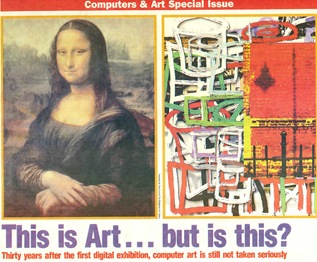
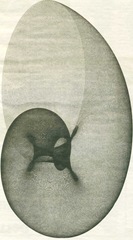
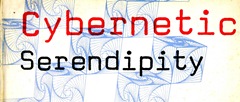
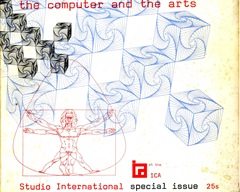
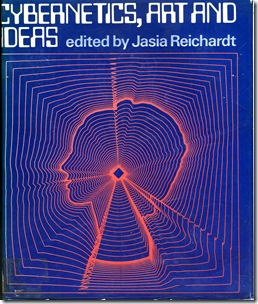
No comments:
Post a Comment